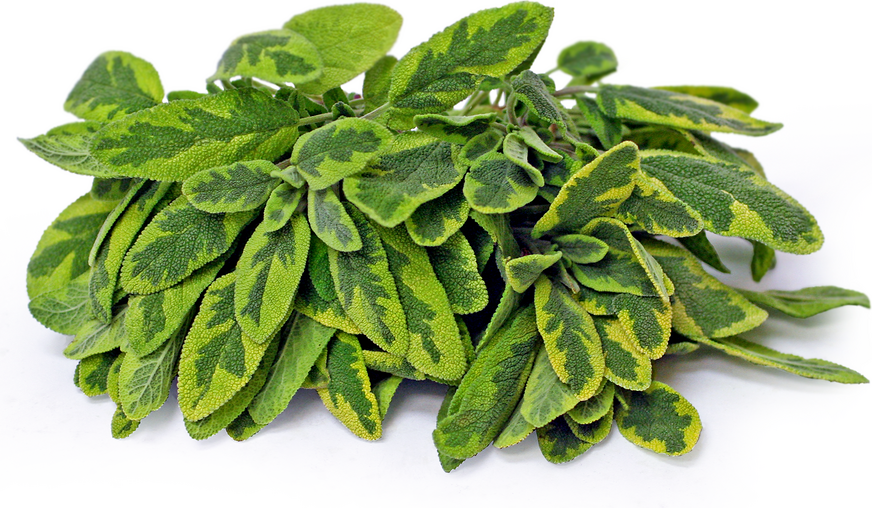


Pineapple Sage
Estimated Inventory, lb : 0
Description/Taste
Pineapple sage is a quick-growing, upright, semi-woody perennial shrub that can reach anywhere from half a meter to 1.5 meters tall and wide, depending on the climate. The ovate yellow-green leaves have a fuzzy surface with slightly serrated edges, and they reach up to about 10 centimeters long, growing opposite along stiff, square stems, which are characteristic of the plant family. Late in the season, the plant produces long clustered spikes of tubular scarlet-red flowers about an inch long. The leaves have a tropical, pineapple-like aroma, especially when crushed, and both the leaves and flowers offer a slightly bitter-sweet citrus and mint flavor.
Seasons/Availability
Pineapple sage is available in the summer.
Current Facts
Pineapple sage is botanically classified as Salvia elegans and is a member of the Lamiaceae or mint family. It earned its common name because of the tropical scent the leaves emit when crushed, similar to a pineapple. There are several unique cultivars of Pineapple sage, such as Tangerine, Golden Delicious, and Honey Melon, each of which offers slight variations in flower color, size, or smell. Pineapple sage is used for both culinary and ornamental purposes. The vibrant red flowers are popular for flower arrangements, but they also attract butterflies and hummingbirds in home gardens.
Nutritional Value
Pineapple sage is rich in vitamin K and is a good source of vitamins A, C, and B6. It also contains manganese, dietary fiber, potassium, and folate and is said to have some anti-depressant and anti-anxiety properties. Like other members of the mint family, Pineapple sage has traditionally been used in herbal medicine to aid in digestion and settle an upset stomach. It has also historically been used to combat insomnia, lower blood pressure, and treat anxiety and nervous system disorders. The characteristic red flowers of Pineapple sage are a good source of antioxidants as they get their color from the presence of anthocyanins, naturally occurring compounds with strong antioxidative and antimicrobial properties that are beneficial for overall health and wellbeing.
Applications
Pineapple sage is most commonly used fresh or dried, and the younger fresh leaves are often preferred for their stronger pineapple-like aroma. They can be steeped in hot water to make tea, chopped and added to baked goods like bread, scones, and muffins, or used to infuse a slightly sweet, herby flavor in vinegar, honey, or even ice cubes. Both the leaves and flowers are edible and can be added to fresh or fruit salads, used to make jelly and jam, or served as a garnish for cocktails, herbal teas, desserts, or even cold soups like gazpacho. Use Pineapple sage in salsas, vinaigrettes, and marinades, or try mincing the leaves and flowers and mixing with cream cheese for a fruity spread. While common sage is known for pairing with savory sausage or poultry dishes, Pineapple sage's tropical, citrusy flavor lends itself more towards sweet dishes; hence, it is not recommended as a substitute in recipes that call for common sage. To store, wrap Pineapple sage in a damp towel and keep it in a bag or container in the refrigerator for up to four days. The leaves and flowers can be dried for extended use, though the fruity aroma will fade with drying.
Ethnic/Cultural Info
Pineapple sage is known by several names in Mexico, such as Mirto, Hierba Del Burro, and Mirto de Flor Roja. It is widely used in Mexican traditional medicine, especially as a natural treatment for stress and anxiety. Its botanical name, Salvia, is derived from the Latin word salvere, which translates as “to save,” referring to the healing properties that have long been attributed to species within the Salvia genus. Pineapple sage was traditionally prescribed to help treat hypertension, aid in digestion, and cool the body during sweltering summers.
Geography/History
Pineapple sage is native to Mexico and Guatemala, growing wild along the edges of pine and oak forests in the Sierra Madre del Sur mountains. It was introduced to the United States as an ornamental plant during the late 19th century. Pineapple sage is a tender plant that thrives in warmer climates as it will not survive a freeze. It can be grown in home gardens or found at local farmers markets and specialty stores.
Recipe Ideas
Recipes that include Pineapple Sage. One
| The Food Channel |
|
Pan Seared Cod with Pineapple Sage Pesto |
| The Flo Show |
|
Pineapple Sage Salad |




